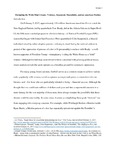Disrupting the White Man's Game: Violence, Hegemonic Masculinity, and an American Pastime

View/
Author
Soman, Shaun Michael
Subject
Washington and Lee University -- Capstone in Women's, Gender, and Sexuality Studies
National Football League
Sex discrimination in sports
Racism in sports
Intersectionality
Metadata
Show full item recordDescription
Capstone; [FULL-TEXT FREELY AVAILABLE ONLINE] Shaun Michael Soman is a member of the Class of 2017 of Washington and Lee University. In this paper, I address how womxn, LGBTQ individuals, persons of color, and non-Americans are simultaneously conceptualized or represented within and excluded from the white, hyper-masculine, ultra-nationalist realm of professional football. Despite the manifold connections one may readily discern between the NFL and broad issues such as classism, imperialism, and environmental degradation, I concern myself in this particular work with three general areas of concern. First, I examine how womxn are subjected to and objectified by the “male gaze” as cheerleaders and, in the case of the Legends Football League, players themselves; grounding this portion of my analysis in the work of Laura Mulvey and Naomi Wolf, I demonstrate how the “gridiron” is erected – and vigilantly defended – as a final bastion of masculinity. Second, by deconstructing the language used by play-by-play commentators and referring to Jasbir Puar and Amit Rai’s work on “heterosexual patriotism,” I attempt to establish a link between the overtly sexualized, though hypothetical, violence committed against the “Other” team and the problematic depiction of the terrorist as a sexually perverse, queered individual deserving of actual sexualized violence. Third, by examining the responses to Kaepernick’s national-anthem protest and Beyoncé’s performance during the Super Bowl 50 halftime show, I interrogate how black bodies are interpreted within a space dominated by whiteness. Returning finally to Tom Brady, I demonstrate that while black bodies may be allowed within the domain of football, the NFL’s disproportionate number of white owners, coaches, and quarterbacks – sometimes referred to as “field generals” – reinforces white supremacy. Ultimately, I offer this work as an initial step within a praxis of rendering visible – and responding to – those obscured forms of oppression; in doing so, I stress that we may undertake a collective opposition to the NFL concurrently alongside other forms of resistance.